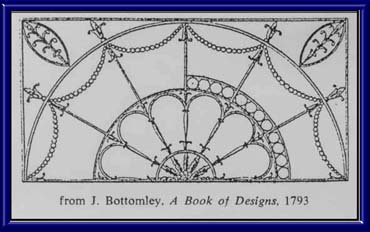
Fanlights with wooden glazing bars occur early in the eighteenth century, but the demand from architects of the 1740s for more fanciful shapes led to the introduction of metal fanlights.
In 1744 Francis Underwood patented a composite glazing bar consisting of lead mouldings soldered onto a metal strip, which became the standard method of fanlight manufacture.
In the 1770s, the architect Robert Adams decorative ideas were readily expressed byUnderwood’s fanlights whose delicate tracery could be overlaid by a variety of cast lead ornaments

Around this time, fanlight making became a specialist trade and in 1793 Joseph Bottomley, a former partner of Francis Underwood published his influential book of designs
The turn of the century witnessed a change in fanlight design towards simpler versions based on circles and curves, and with the introduction of gas lighting into towns, some even incorporated a lantern.
These designs persisted into the 1840s until the arrival of good quality sheet glass in large panes made the sub division of glass unnecessary and fanlights went out of fashion.
Our Services
As well as fanlights, we offer other services including reproductions of Georgian metal skylights , bronze glazing bars for windows and stained glass conservation at the highest level.